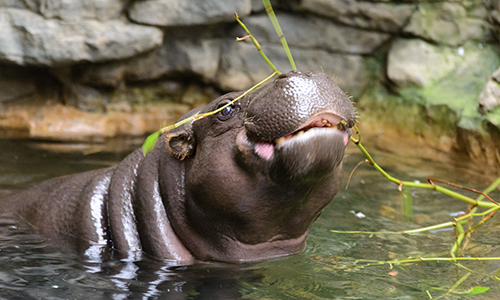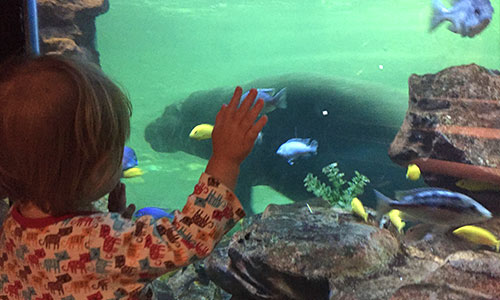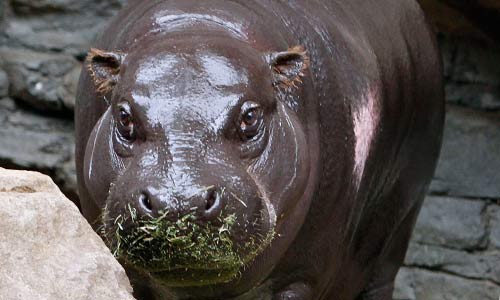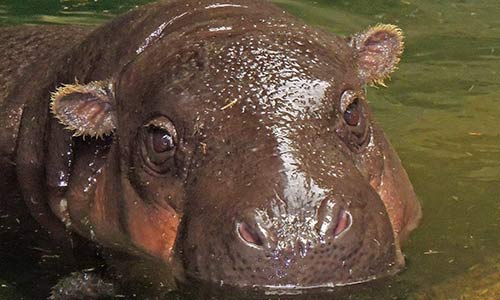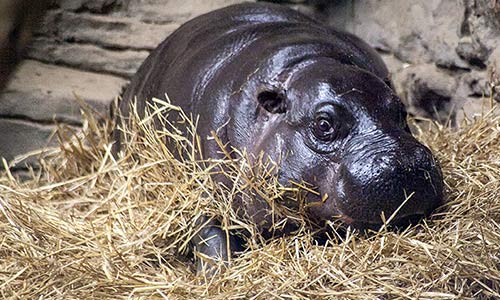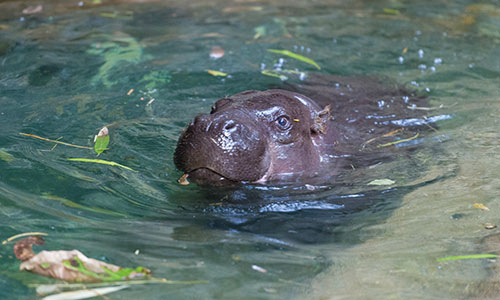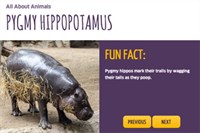Pygmy Hippopotamus
Choeropsis liberiensis
About the Pygmy Hippopotamus

Geographic Range:
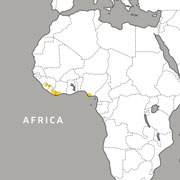
Class: Mammalia
Order: Cetartiodactyla
Family: Hippopotamidae
Genus: Choeropsis
Species: liberiensis
The pygmy hippo is a stout animal with a relatively small and rounded head and thick blackish skin. Like the larger Nile hippo, it excretes reddish droplets that soften and protect its skin. This creature is solitary and secretive in the wild. It's not vicious, but can be dangerous when disturbed. The pygmy hippo will attempt to intimidate potential enemies by opening its jaws and baring its canine teeth.
Committed to Conservation
Zoo New England participates in the pygmy hippopotamus Species Survival Plan. By sharing research and knowledge, participating institutions work together to establish guidelines that best ensure the health of captive populations, and with success, the survival of endangered species.
Pygmy Hippo Facts
Appearance:
Compared to the Nile hippopotamus, the pygmy hippo is somewhat more than half its size, and its limbs are proportionally longer. Its head is relatively small and rounded; the eyes are not prominent and are set to the side. The thick, naked skin is uniformly blackish and somewhat lighter below. Like the Nile hippo, pygmy hippos exude reddish-colored droplets which soften and protect the skin.
Adult Size:
- Length: 4.9 - 5.7 feet
- Height: 30 - 39 inches
- Weight: 350 - 600 pounds
- Birth weight: approximately 5.7 kg.
Diet:
These herbivores ingest terrestrial and semi-aquatic plants including ferns, leaves of young trees, fruits stems, succulent root stalks, and herbs, with grasses playing no role in their natural diet. Preferred plants have high sodium content, which may meet hippos' nutritional demand for salt.
Reproduction:
Pygmy hippos haven't shown a specific breeding season in captivity, and their behavior in the wild is difficult to determine. Their reproductive phase is between 2 to 32 years for both sexes. A single offspring is born after a gestation period of 187 to 214 days.
The mother/calf bond is extremely close, and the mother hippo will lick and nuzzle her baby. A pygmy hippo calf can nurse from its mother on land or underwater. Calves are weaned after six to eight months and are sexually mature at 4 to 5 years of age.
Behavior:
Pygmy hippos are solitary creatures. Males and females only come together during estrus. The male hippo wanders over a home range that overlaps with several female ranges and possibly other male ranges, but he will chase male competitors out of his territory.
Females often ignore other females and will avoid each other by using their sense of smell, marking pathways with their dung (which in turn fertilizes plants). This foraging, both on land and in water, creates pathways and canals that other animals use to get through dense underbrush.
A hippo's sense of smell and hearing are its primary senses; vision is secondary. A male hippo's sense of smell is two to three times larger than that of a female.
Pygmy hippos actively browse for food between 4 and 11 p.m. Not fully nocturnal, hippos sleep primarily from midnight until early afternoon.
Male and female hippos will communicate during mating season. This includes male vocalization (grunts and bellows), increased activity levels, and increases in dung marking. Females may exhibit a deep audible breathing pattern, respond to male calls, and show increased interest in a male hippo. If introduced, they will often move in a circular fashion following each other head to tail.
Pygmy hippos are not aggressive, often fleeing from threat, but they can be dangerous when surprised or disturbed. Threat and warning displays include chomping, water scooping and head shaking; rearing, lunging, and roaring grunts.
Habitat/Range:
Pygmy hippos currently reside in Côte d'Ivoire (Ivory Coast), Guinea, Liberia, and Sierra Leone. They are extinct from Nigeria. Their natural habitat includes wetlands, forest and savanna.
Median Life Expectancy:
13 years in the wild
In captivity, individuals can live between 35 and 45 years.
Threats:
The main threats to pygmy hippos are habitat loss and hunting. Their habitat is becoming fragmented and developed through logging and wood-harvest, mining and quarrying. Although they're not major targets of the bushmeat trade, opportunistic hunters that stumble upon pygmy hippos will kill them for their meat.
What you can do:
Shop sustainably by looking for the FSC (Forest Stewardship Council) logo on paper products and the RSPO Sustainable Palm Oil logo on food and hygiene products to help protect hippos’ Habitat. Recycling electronics and rechargeable batteries help reduce pressure for mineral mining in their home range.
Did you know?
Whales are the closest living relatives to hippos.
Read more about the first pygmy hippo born at Zoo New England.
You Can Find This Animal in the Tropical Forest
Just for Kids!
Learn more about our hippos in the Kids' Corner!
You Can Help!
Pygmy hippos are at risk of extinction in the wild largely due to habitat fragmentation and destruction. Shopping sustainably by looking for the Forest Stewardship Council (FSC) logo on paper products and the RSPO Sustainable Palm Oil logo on food and hygiene products can help protect the hippo’s habitat.


You may also like
At Franklin Park Zoo:
At Stone Zoo:

